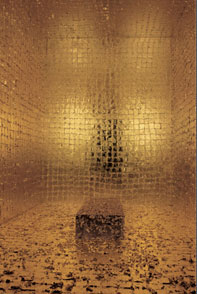[From the exhibition notes:]
Byars's art and life reflect a sustained, creative engagement with Asian aesthetics and spiritual philosophy. He was introduced to Japan by the artist Morris Graves and from 1957 to 1967 he lived in Kyoto, the center of traditional Japanese arts and culture, seeking out the study and practice of Zen meditation, Shinto ritual, a classical No dance theater. Byars drew eclectically from No's slow, stylized movement and medieval dramas of the supernatural realm to forge a contemporary performance art that was highly abstract, poetic, and ceremonial. A self-styled Eastern mystic who dressed in all-black or all-gold costumes, Byars identified with Asia's concept of death as a mental state of eternal perfection and self transcendence, which influenced the material, spectacular quality, and themes of his performance, sculpture, and installation art.
Byars's work explores the phenomenon of presence. He plays between the immediate living moment and an evocation of death as a realm of the eternal. The Death of James Lee Byars (1982/94) was created as the site for a performance based on earlier works exploring the artist's own "departure" from the real world. The installation presents a gold-leafed room where Byars enacted his symbolic death with a glass sarcophagus and five crystals left as a bodily trace. The performance instructions read: "Quietly lie down and quietly get up." This shimmering space invites contemplation of an otherworldly state of being—not just of transcendent death, but of the East, whose grace it conjures.
Like Byars, all the exhibition artists in The Third Mind were born before 1960. For these artists, foreign travel was part escape, part enlightenment, and grounded in an Orientalist tradition that sought self-betterment through the selective appropriation of ideas, practices, relationships, and material artifacts that represented a superior alternative to Europe and America. After 1990, artists traveled less for personal research and far more as participants in the biennials and other international shows that nave proliferated around the globe over the last two decades. This development has paralleled globalization and the consequent shift in the nature of no knowledge is transmitted. While earlier generations idealized knowledge and art, contemporary generations value information, culture, and critique. This shift is key to understanding a specific trajectory of America art thought that this exhibition reveals. |

